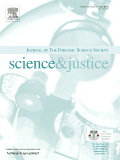
SCIENCE & JUSTICE
Scope & Guideline
Where Scientific Innovation Meets Justice Integrity.
Introduction
Aims and Scopes
- Forensic Methodologies and Techniques:
Focuses on the development and validation of novel forensic techniques and methodologies, including advanced imaging technologies, chemical analysis, and DNA profiling methods. - Forensic Applications of Technology:
Explores the integration of cutting-edge technologies such as artificial intelligence, machine learning, and augmented reality in forensic science, enhancing investigative processes and evidence analysis. - Interdisciplinary Research:
Encourages collaborations across various disciplines, including anthropology, biology, chemistry, and digital forensics, to address complex forensic challenges and improve investigative outcomes. - Ethical and Legal Considerations in Forensics:
Addresses the ethical implications and legal frameworks surrounding forensic practices, particularly in relation to evidence handling, data privacy, and the use of forensic evidence in court. - Environmental and Contextual Forensics:
Investigates the role of environmental factors and contextual elements in forensic analysis, including the study of trace evidence, decomposition processes, and the use of environmental DNA.
Trending and Emerging
- Digital Forensics and Cybersecurity:
An increasing number of publications focus on digital forensics, including the analysis of digital evidence, cybersecurity threats, and the implications of digital data in criminal investigations. - Forensic Genetics and DNA Analysis:
Research on advanced DNA analysis techniques, including next-generation sequencing and probabilistic genotyping, has gained traction, reflecting the critical role of genetics in forensic identification. - Integration of Artificial Intelligence (AI) in Forensics:
There is a growing interest in the application of AI and machine learning algorithms for predictive modeling, evidence analysis, and enhancing forensic methodologies. - Environmental Forensics and eDNA:
The use of environmental DNA (eDNA) for wildlife crime investigations and other forensic applications is emerging as a key area of research, emphasizing the intersection of ecology and forensics. - Ethics in Forensic Science:
A noticeable trend towards exploring ethical issues in forensic science, including the implications of bias, data privacy, and the responsibilities of forensic practitioners, is becoming more prominent in recent publications.
Declining or Waning
- Traditional Forensic Evidence Collection Techniques:
There has been a noticeable decrease in research focusing on conventional evidence collection methods, as newer technologies and methodologies become more prevalent in forensic practice. - General Crime Scene Management Practices:
The emphasis on generic crime scene management techniques appears to be waning, with more focus shifting towards specific forensic applications and technological innovations. - Non-Scientific Approaches to Forensic Analysis:
Papers that rely on anecdotal evidence or non-scientific methodologies are becoming less frequent, as the journal prioritizes rigorous scientific approaches and empirical research.
Similar Journals
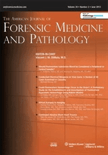
AMERICAN JOURNAL OF FORENSIC MEDICINE AND PATHOLOGY
Exploring the Intersection of Medicine and LawThe American Journal of Forensic Medicine and Pathology is a pivotal publication within the field of forensic science and pathology, dedicated to disseminating influential research and advancements in the evaluation of death and injury in legal contexts. Published by Lippincott Williams & Wilkins, this journal, which has been in circulation since 1980, serves as a vital resource for professionals, researchers, and students focused on intersecting disciplines such as medicine and forensic investigations. While it holds a respectable Q3 ranking in both the Medicine (Miscellaneous) and Pathology and Forensic Medicine categories as of 2023, the journal's impact is underscored by its contributions to the ongoing dialogue on forensic practices and methodologies. The American Journal of Forensic Medicine and Pathology provides a platform for innovative papers that shape the future of forensic science, also offering insights through case studies, reviews, and research articles that cater to its diverse readership. With an ISSN of 0195-7910 and E-ISSN 1533-404X, the journal continues to support the scholarly community in advancing knowledge within this critical field.
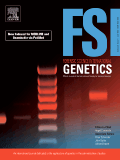
Forensic Science International-Genetics
Pioneering the Intersection of Genetics and Forensic AnalysisForensic Science International-Genetics, published by Elsevier Ireland Ltd, stands as a pivotal resource in the realm of forensic science, particularly focusing on the intricate interplay of genetics within legal contexts. With an E-ISSN of 1878-0326, this esteemed journal serves to advance the understanding of genetic applications in forensic scenarios, enhancing methodologies and promoting innovations in evidence analysis. Recognized in the 2023 Q1 quartile rankings in both Genetics and Pathology and Forensic Medicine, it has established itself as a leading journal, positioned in the 87th percentile in the field of Pathology and Forensic Medicine. The journal spans valuable research from 2007 to 2025, making it a critical chronicle of evolving forensic practices. Researchers, professionals, and students alike will find an extensive compendium of peer-reviewed articles that not only address current challenges in forensic genetics but also foster collaboration and innovation across the scientific community. As a non-open access journal, it ensures high-quality content while offering insights essential for both academic study and practical application in forensic investigations.

International Journal of Electronic Security and Digital Forensics
Illuminating the path to robust electronic security practices.The International Journal of Electronic Security and Digital Forensics, published by INDERSCIENCE ENTERPRISES LTD, is a leading platform for disseminating scholarly research in the realms of cybersecurity, digital forensics, and electronic security. Established with the objective of bridging the gap between theoretical advancements and practical applications, the journal spans critical areas such as network security, legal implications of digital forensics, and reliability in safety measures. With its ISSN 1751-911X and E-ISSN 1751-9128, the journal aims to provide valuable insights into emerging technologies and methodologies while maintaining high academic standards, as reflected in its diverse quartile rankings across multiple categories in 2023. Operating from the United Kingdom and catering to a global audience, the journal is committed to fostering innovative research that contributes to safer digital environments. Researchers, professionals, and students will find a wealth of information and opportunities for collaboration in this specialized field, making International Journal of Electronic Security and Digital Forensics an essential resource for advancing knowledge and practice.

Anil Aggrawals Internet Journal of Forensic Medicine and Toxicology
Exploring the Intersection of Science and JusticeAnil Aggrawals Internet Journal of Forensic Medicine and Toxicology, an esteemed publication in the field of forensic medicine and toxicology, is dedicated to disseminating innovative research and critical insights since 2000. Published by ANIL AGGRAWALS INTERNET JOURNAL FORENSIC MEDICINE & TOXICOLOGY, the journal caters to professionals, researchers, and students keen on advancing their understanding of forensic science, including its intersections with law and public health. Although it currently holds a Q4 quartile ranking in Law, Pathology and Forensic Medicine, and Toxicology, the journal provides a vital platform for underrepresented studies, encouraging a diverse range of scholarly contributions. With its open access model, the journal enhances visibility and accessibility, ensuring that valuable research can reach a wider audience. As the journal continues to evolve, it plays a crucial role in bridging theoretical knowledge and practical applications, thereby enriching the discourse within its fields of study and fostering inter-disciplinary collaborations.
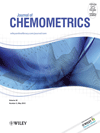
JOURNAL OF CHEMOMETRICS
Unveiling the Power of Chemometric TechniquesJOURNAL OF CHEMOMETRICS is a prestigious journal published by Wiley that has been a cornerstone in the fields of analytical chemistry and applied mathematics since its inception in 1992. With an ISSN of 0886-9383 and an E-ISSN of 1099-128X, this journal occupies a notable position, reflected in its Scopus rankings where it holds the 90th rank in Applied Mathematics and the 56th rank in Analytical Chemistry. The journal, based in the United Kingdom, spans a converged publication timeline through 2024, meticulously exploring the interplay between chemical data analysis and mathematical methodologies. Though currently not open access, it offers essential insights through high-quality research articles that significantly contribute to advancing the understanding of chemometric techniques and their applications. With an impact factor demonstrating robust academic recognition, the JOURNAL OF CHEMOMETRICS serves as an invaluable resource for researchers, professionals, and students aiming to excel in the ever-evolving landscape of chemical data interpretation.
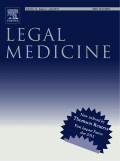
Legal Medicine
Fostering knowledge at the crossroads of ethics and practice.Legal Medicine, ISSN 1344-6223, published by ELSEVIER IRELAND LTD, stands as a pivotal academic journal within the realms of forensic medicine and legal ethics. Operating from the Netherlands, this journal has established a strong reputation among researchers and practitioners since its inception in 1999, with the goal of advancing knowledge in the intersection of legal and medical disciplines. With a commendable Q2 categorization in both Issues, Ethics and Legal Aspects and Pathology and Forensic Medicine, it ranks among the noteworthy publications in these fields, placing it in the 51st percentile for Pathology and Forensic Medicine and 51st for Nursing-related ethical issues. The journal not only serves as a repository for innovative research and practical case studies but also emphasizes the importance of ethical considerations in medical legal scenarios. Although it does not offer Open Access options, it remains a crucial resource for professionals, researchers, and students seeking to stay informed about the latest developments that shape legal medicine. Access to its contents promises to enhance understanding and inspire advancements in both forensic science and the ethical frameworks surrounding them.
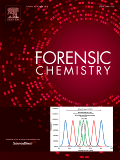
Forensic Chemistry
Transforming evidence into insights through chemistry.Forensic Chemistry is a premier journal published by Elsevier, specializing in the interdisciplinary field of forensic science, with a strong emphasis on analytical and materials chemistry, pathology, and law. Established in 2016 and converging to a significant publication trajectory through 2024, the journal has rapidly ascended to an impressive Q1 ranking across multiple categories, demonstrating its impact and commitment to advancing forensic analysis and methodologies. With an impact factor reflecting its relevance—especially notable with a 95th percentile rank in Social Sciences and Law—Forensic Chemistry serves as an essential resource for researchers, legal authorities, and academics seeking to explore the latest developments in forensic techniques and applications. Its rigorous peer-review process and high-quality publications ensure that it remains at the forefront of scientific inquiry in forensic practices. Access to the journal is available without an open access model, further emphasizing its commitment to curated, high-impact scholarship that contributes to both theoretical foundations and practical applications in the forensic field.

Rechtsmedizin
Pioneering Research in Forensic PathologyRechtsmedizin is a prestigious academic journal published by Springer, focusing on the critical field of forensic medicine and pathology. With a legacy dating back to 1995, this journal serves as a vital platform for disseminating advanced research and clinical findings that enhance the understanding of legal medicine and forensic science. Although it currently does not offer open access, it boasts an impressive Q3 ranking in 2023 within its category, indicative of its contribution to the field, with a Scopus rank of #149 out of 208 in Medicine, placing it within the 28th percentile of its peers. As a dedicated resource for researchers, professionals, and students, Rechtsmedizin aims to bridge the gap between clinical practice and forensic investigation, promoting the integration of scientific advancements into everyday applications within the legal context. With its location in New York City, USA, the journal remains a key player in the global discourse on forensic issues, thus inviting submissions that push the boundaries of traditional forensic methodologies and explore innovative approaches in legal medicine.

Forensic Science International Genetics Supplement Series
Bridging the gap between genetics and forensic applications.Forensic Science International Genetics Supplement Series, published by Elsevier Ireland Ltd, is an essential resource for professionals, researchers, and students engaged in the increasingly critical intersection of genetics and forensic science. This peer-reviewed journal, with an ISSN of 1875-1768 and E-ISSN of 1875-175X, provides a platform for disseminating innovative research findings and methodologies that enhance the application of genetic techniques in forensic investigations. The journal has gained recognition within the academic community, evidenced by its notable rankings in Pathology and Forensic Medicine as well as Genetics, placing it in Q3 and Q4 quartiles respectively in 2023. Although it operates without an open access model, its targeted converged years—spanning from 2008 to 2022—exemplify a commitment to fostering ongoing advancements in forensic genetics. Despite its positioning, the journal remains a significant contributor to public discourse, with an emphasis on the role of genetics in legal contexts and the continual evolution of forensic methodologies.

MEDICINE SCIENCE AND THE LAW
Advancing Knowledge at the Intersection of Medicine and LawMEDICINE SCIENCE AND THE LAW is a prestigious journal published by SAGE PUBLICATIONS INC, focused on the intersection of law, health policy, and ethical issues as they pertain to medicine. With a long-standing history dating back to 1960, this journal has become a crucial platform for scholars and professionals alike to share and disseminate research that shapes the evolving legal landscape surrounding health care practices. It holds notable positions in the academic community, ranking in the Q3 category for Health Policy and Issues, Ethics and Legal Aspects, and achieving a distinguished Q1 ranking in Law as of 2023. With rigorous peer-review standards and a commitment to publishing high-quality research, MEDICINE SCIENCE AND THE LAW is invaluable for those exploring the critical legal challenges and ethical dilemmas faced within the healthcare sector. Research contributions are vital for informing policy and practice, ensuring that the journal remains a relevant and essential resource for researchers, practitioners, and students dedicated to the intersection of law and medicine.